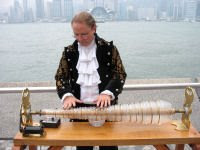
As the crow flies, the Generalife is not that far away from the Alhambra. In this picture we're looking at the Generalife with the Alhambra about 500 yards to the right. Remember that old real estate adage, "Location, location, location!?" Well, that's certainly true of the Generalife. Geographically, it's not that far from the palaces and intriques of the court but both figuratively and literally it provided a much needed respite.
The Generalife's location allows it to profit more fully from the breezes that come down from the Sierra Nevada and be that much cooler and shadier than the Alhambra. The fountains, shaded arcades and gardens of the Generalife provided a much needed physical and mental respite for the rulers of Granada. Here is a photo of the rooms of the Sala Regia overlooking the Patio de la Acequia, the enclosed oriental garden with a long, central pool and water jets on either side.

The Patio de los Cipreses has a history of clandestine meetings between Zoraya, wife of the Sultan Abu-l-Hasan, and her lover who was the chief of the powerful Abencerrajes family. It is also known as the Patio de la Sultana for obvious reasons. While being a very beautiful place for romantic intriques it just doesn't seem all that discreet to me. Check out all of the windows and arcades which could easily hide secret observers! It's said that "love is blind" but, unfortunately, that is probably for the spied upon rather than for the spy!

Here's a view from the opposite end of the garden. It certainly is a romantic spot......
A door off this court leads to enclosed gardens and the Escalera del Agua. This amazing staircase is almost completely covered by trees and bushes and has water flowing gently down either sides.
Again, the sound of water is found everywhere in the Generalife and adds to the feeling of coolness that pervades even on the hottest days. Our visit was on a day when the temperatures probably peaked in the mid 80's but with a nice breeze coming from the Sierra Nevada for most of the day.
A few more photos from around the palace.

A view of the Alhambra and of the Albaicin, the old neighborhood at the bottom of the Darro ravine north of the Alhambra


Gorgeous gardens surround much of the Generalife. One of the translations of Generalife is "the garden of lofty paradise." "Back in the day" in the 13th century the gardens also had orchards and pastures. Here's what they look like today.




I'm sure that Freud would have a field day with my penchant for hiding behind or peeking through leafy objects when having my photo taken! Let's not go there.
 No garden on this hill or "pile" as Washington Irving pronounced it would be complete without fountains, flowers and the sound and sight of water.
No garden on this hill or "pile" as Washington Irving pronounced it would be complete without fountains, flowers and the sound and sight of water.When I become filthy rich and spread my largesse far and wide in attempts to improve the human condition, I will set aside a few million to rent the Alhambra for a week and invite my friends to share this spectacular retreat with me.
My jealousy of the aforementioned Irving knows no bounds! I've been reading his "The Alhambra" and am sometimes struck, almost literally, by a feeling of envy so strong as to almost be sickening.
He had much of this "glorious pile" to himself, and those that he shared it with were not carrying cameras, audio guides or escorting throngs of teenagers.

Can't you just see yourself strolling along here with the sounds of guitars drifting up from the town below? For a much better description read "Tales of the Alhambra" by Washington Irving. Try to get a copy with pictures because then, like me, you can sway in your hammock while reading, and with an occasional glance at the pictures, pretend that you are there.






































































